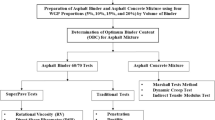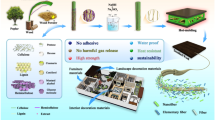Abstract
Glass fibre reinforced gypsum, modified by addition of specially selected and developed thermosetting polymers, is the basis of a new composite material, called PGRG. An investigation has been performed into its mechanical properties such as bending strength, tensile strength and long-term performance under constant load and fatigue load. The influence of moisture and temperature on mechanical properties has been determined. The equilibrium moisture content at various relative humidities, the moisture content under natural weathering conditions, the coefficient of linear expansion and the microstructure have been studied. Furthermore, the durability has been investigated under accelerated ageing conditions and outdoor exposure. The results have shown that the polymer-modified glass fibre reinforced gypsum has good mechanical properties under tension and, unlike unmodified gypsum, is resistant to the Western European climate. A variety of new outdoor applications for gypsum are likely to be possible now: The material has already been used successfully for outdoor applications in the UK, the Middle East and The Netherlands.
Resume
Le plâtre renforcé de fibres de verre, modifié par l'addition de polymère thermodurcissable spécialement sélectionné et fabriqué, forme la base d'un nouveau matériau composite appelé PGRG, dont on a examiné certaines propriétés mécaniques: résistance à la flexion, à la traction et performance à long terme sous charge constante et charge de fatigue. On a déterminé l'influence de l'humidité et de la température sur les propriétés mécaniques. On a également étudié l'équilibre de la teneur en eau à différentes humidités relatives, la teneur en eau en exposition naturelle, le coefficient d'expansion linéaire et la microstructure. On a aussi examiné la durabilité dans des conditions de vieillissement accéléré et l'exposition à l'atmosphère. Les résultats ont montré que les propriétés mécaniques du composite sont bonnes et que, à la différence du plâtre non traité, il peut résister au climat d'Europe Occidentale. Ceci permet d'envisager maintenant pour le plâtre diverses applications en ouvrages extérieurs. Le matériau a déjà été utilisé avec succès pour ce type d'applications en Grande-Bretagne, aux Pays-Bas et au Moyen-Orient.
Similar content being viewed by others
References
Plas, C. van der, ‘Properties of polymer-modified glass fibre reinforced gypsum’ (Eigenschappen van polymeergemodificeerd glasvezelversterkt gips, PGVG), INTRON Report No. 89312.
RILEM Technical Committee 48 TFR, ‘RILEM draft recommendations: testing methods for fibre reinforced cement-based composites’,Matér. Constr.,17(102) (1984) 441–456.
‘Cladding panels of glass fibre reinforced cement’ (Gevelelementen van glasvezelversterkt cement), (STUPRE, 1988).
Bijen, J. and Jacobs, M., ‘Properties of glass fibre reinforced polymer-modified cement’,Matér, Constr.,15(89) (1982) 446–452.
Bijen, J. and Selst, R. van, ‘Possibilities for increasing the weather resistance of gypsum products’ (Mogelijkheden tot het verhogen van de weerbestandheid van rogipsprodukten), INTRON Report No. 88271.
Author information
Authors and Affiliations
Rights and permissions
About this article
Cite this article
Bijen, J., van der Plas, C. Polymer-modified glass fibre reinforced gypsum. Materials and Structures 25, 107–114 (1992). https://doi.org/10.1007/BF02472464
Issue Date:
DOI: https://doi.org/10.1007/BF02472464




